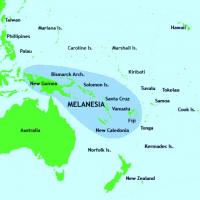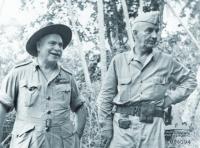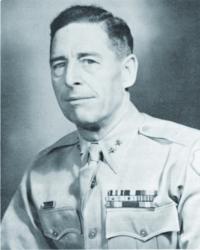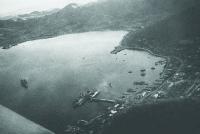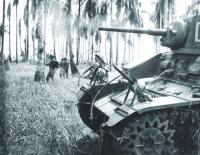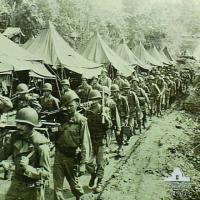This week, 70 years ago, the Imperial Japanese Army was continuing its attempt to capture Port Moresby, which is located on the southern coast of the eastern end of the Island of New Guinea. Port Moresby currently has a population of 307,000, but is ranked as one of the world’s least livable cities. New Guinea is the second largest island in the world, behind Greenland, and is located to the north of Australia.
When the Japanese entered World War II against the western nations, the eastern half of New Guinea was being administered by Australia, while the western half was being administered by the Netherlands. With the capture of Port Moresby, Australia’s most densely populated and industrialized area would come within range of Japanese Air and Naval forces.
The Imperial Japanese Navy had sent an amphibious invasion force under the overall command of Admiral Shigeyoshi Inoue to capture Port Moresby. However, the United States Navy, together with the Royal Australian Navy, under the command of Admiral Frank J. Fletcher, thwarted the effort in the Battle of Coral Sea in the first week of May. It was the first time that a Japanese operation in the Pacific had been thwarted.
In March of that year, the Japanese had captured the small city of Lae, and the smaller town of Salamaua on the northern coast of the eastern part of the island. In 2000, Lae had a population of 73,000. With the failure of the naval expedition, and the disaster at Midway the following month, the Japanese resolved to capture Port Moresby by land. In order to do that, they would have to cross the Owen Stanley Mountain Range, from their bases at Lae and Salamaua, which had peaks in excess of 13,000 ft. The only way to traverse the Owen Stanley Mountain Range, anywhere close to Port Moresby was the Kokoda Trail. This was a single file tract starting just outside Port Moresby on the Coral Sea, running 62 miles across the mountain range, which was passable only on foot.
In July 1942, the Japanese had landed on the northern coast of the island and occupied and established bases at the tiny coastal villages of Buna, Gona and Sanananda. After a day long battle, the 77 Australian soldiers bowed to the inevitable, and withdrew from the Kokoda air base on July 29.
With the base in their hands, the Japanese embarked on a mission to capture Port Moresby. But before it could be effected, the Aussies recaptured the base on August 8, losing it again on August 14. This time, they withdrew over the Owen Stanleys. In the meantime, two divisions under the command of Maj.-Gen. Tomitar Horii were en route from the nearby Japanese base at Rabaul. These troops began arriving on the north coast on August 26.
The Australian Parliament, convinced that Port Moresby was going to fall, ordered the unpopular Commander-in-Chief, Thomas Blamey, to go there, saying, "Send Blamey up there and let him fall with it!" He arrived on September 23. Meanwhile, General Horii’s soldiers had been pushing across the Owen Stanleys along the Kokoda Trail toward Port Moresby. On September 21, the Japanese reached an Australian defensive position on the Trail at Ioribaiwa. From there, they could see the lights of Port Moresby and the Coral Sea. They were 30 miles from the city. But, with the failure of the Japanese effort on Guadalcanal, the Imperial General Headquarters decided that they did not have the resources to continue both operations. Therefore, General Horii was ordered to withdraw his forces to the coastal bases and await developments on Guadalcanal. Even without this order, General Horii had decided against any offensive action against Port Moresby, because of the deplorable physical condition of his troops. They were so hungry and weak that the General was unsure if they could even defend their position, let alone mount an offensive. Disease had wounded, killed or disabled 80 percent of his troops.
Meanwhile, the Australians were pouring reinforcements into Port Moresby. On November 16, the Allies, having been reinforced by U.S. 32nd Infantry Division, commanded by Maj.-Gen. Edwin F. Harding, assaulted the Japanese positions at Buna, Gona and Sanananda. These were well-prepared, interconnecting defensive positions manned by 6500 well-trained, veteran Japanese soldiers. Gen. Harding had been ordered to attack these positions by Supreme Allied Commander Douglas MacArthur, comfortably ensconced in his headquarters in Port Moresby, "...regardless of the losses." The following day, the Supreme Allied Commander ordered Harding to, "...take Buna today at all costs." After 13 days of little to no progress and high casualties, General MacArthur lost patience and ordered I Corps’ commander Robert Eichelberger to remove 32nd Division’s commanders down to the battalion level. Gen. Harding was replaced, on December 2, by the division’s artillery commander Albert W. Waldron. Three days later, Waldron was wounded. Eichelberger replaced him with his own Chief-of-Staff, Clovis Byers, who, in turn, was also wounded on December 16. Since Eichelberger was the only general left, he assumed command. It was only then that he realized just how bad things were. The soldiers, who were underfed, were suffering from malaria, dengue, bush typhus and tropical dysentery. All were running a fever.
In the meantime, there were changes in the enemy’s command structure, as well. On November 13, as the Japanese retreated from Gorari across the Kumusi River, General Horii had drowned and was replaced by Lt.-Gen. Kensaku Oda, who, in 1943 committed suicide.
The Australians captured Gona on December 8. That same day, the Americans renewed their attack on Buna, finally taking it on January 2, 1943. Sanananda would not be taken for another 20 days. Once these positions were taken, the Allies discovered that Allied prisoners had all been killed, many tortured and some eaten.
For the number of soldiers involved, losses were extraordinarily high: Japanese - 1500; American - 798; Australian - 2700. The 32nd Division suffered an illness rate of 66 percent - malaria, dengue fever, bush typhus. General Eichelberger wrote that, "Buna was bought at a substantial price in death, wounds, disease, despair and human suffering."
Fighting would continue on New Guinea until the end of the war, consuming 216,000 Japanese, Australian and American lives.
NEXT WEEK: NAVAL BATTLE OF CAPE ESPERANCE
Mr. Wimbrow writes from Ocean City, Maryland, where he practices law representing those persons accused of criminal and traffic offenses, and those persons who have suffered a personal injury through no fault of their own. Mr. Wimbrow can be contacted at
wimbrowlaw@gmail.com <mailto:wimbrowlaw@beachin.net>
